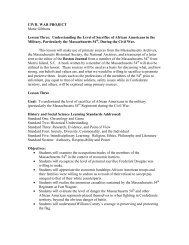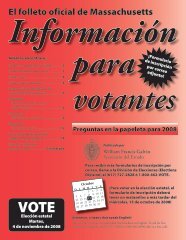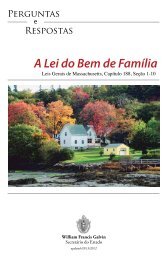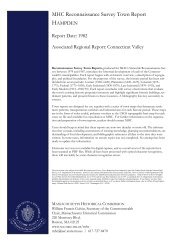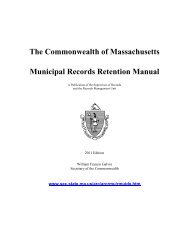Roads, Rails, and Trails - Secretary of the Commonwealth
Roads, Rails, and Trails - Secretary of the Commonwealth
Roads, Rails, and Trails - Secretary of the Commonwealth
Create successful ePaper yourself
Turn your PDF publications into a flip-book with our unique Google optimized e-Paper software.
The flotation procedure was originally developed to<br />
recover seeds from archaeological sites, <strong>and</strong> many were<br />
recovered from 19-NT-50 <strong>and</strong> 19-NT-68. Among <strong>the</strong> most<br />
important seed finds were fragments <strong>of</strong> maize. These were<br />
radiocarbon dated to <strong>the</strong> time just before <strong>and</strong> a bit after first<br />
contact with Europeans. Although only a few kernels were<br />
found, <strong>the</strong>se were <strong>the</strong> first radiocarbon dates for maize on<br />
Nantucket.<br />
This tiny carbonized kernel <strong>of</strong> maize from 19-NT-50 was<br />
harvested sometime between 1440 <strong>and</strong> 1630 AD.<br />
Of course <strong>the</strong>re were shellfish here too. Crunched into<br />
tiny fragments under <strong>the</strong> feet <strong>of</strong> generations, more than 2,000<br />
shell fragments were extracted by <strong>the</strong> archaeologists. Quahog<br />
was <strong>the</strong> most common, both by numbers <strong>of</strong> fragments <strong>and</strong> total<br />
weight, followed by oyster, s<strong>of</strong>t-shell clam (“steamers”), <strong>and</strong><br />
scallops.<br />
Because certain animals only occur in certain places at<br />
certain times <strong>of</strong> <strong>the</strong> year, by identifying <strong>the</strong> types <strong>of</strong> animals at<br />
an archaeological site archaeologists can learn what time(s) <strong>of</strong><br />
<strong>the</strong> year <strong>the</strong> site was occupied. Some <strong>of</strong> <strong>the</strong> fish species from<br />
33<br />
NT-68 (dusky shark, spiny dogfish, <strong>and</strong> sturgeon) are taken<br />
from late spring to early fall; o<strong>the</strong>r marine species (cod <strong>and</strong><br />
grey seal) are available from winter to early spring. Overall,<br />
this suggests that <strong>the</strong> site may have been occupied year-round,<br />
or sometimes one part <strong>of</strong> <strong>the</strong> year <strong>and</strong> sometimes ano<strong>the</strong>r.<br />
Maybe <strong>the</strong>re was a change over time. But change over time<br />
was impossible to track at <strong>the</strong>se sites because <strong>the</strong> living floor <strong>of</strong><br />
<strong>the</strong> dwelling was disturbed by <strong>the</strong> setting <strong>and</strong> removing <strong>of</strong><br />
posts, <strong>the</strong> activities <strong>of</strong> animal burrowers, <strong>and</strong> <strong>the</strong> trampling <strong>of</strong><br />
artifacts into <strong>the</strong> soil. These activities mixed <strong>and</strong> stirred any<br />
distinct layers representing individual occupations; finding<br />
such layers would be an archaeologists dream! The PAL<br />
archaeologists would have to be content with <strong>the</strong> finding <strong>of</strong> not<br />
one but two unprecedented Massachusetts sites that evoked a<br />
remarkable continuity <strong>of</strong> life <strong>and</strong> home.<br />
Atlantic Sturgeon<br />
Grey Seal<br />
The people who lived at <strong>the</strong>se sites fished <strong>and</strong> hunted seals in<br />
<strong>the</strong> teeming waters <strong>of</strong> Nantucket Sound.



